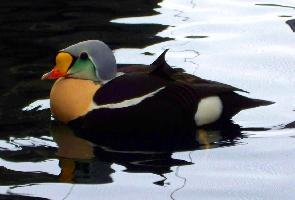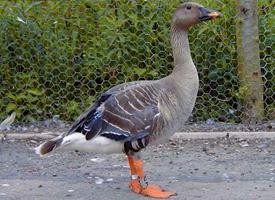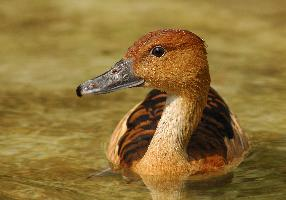
Descrierea animalului
The King Eider (Somateria spectabilis) is a large, striking sea duck that inhabits the northern reaches of the globe, notably within the Arctic Circle. It is renowned for its distinctive and flamboyant plumage, especially in males, and its remarkable life cycle that is intricately adapted to the harsh environments it calls home.Adult male King Eiders are a sight to behold, with a body length that can reach up to 70 cm (28 inches) and a wingspan extending nearly double that length. The male's breeding plumage is particularly eye-catching, featuring a predominantly black and white body that serves as a stark contrast to the vibrant colors on its head. The head itself is adorned with a striking combination of pale blue crown and cheek patches, a green nape, and a red bill. Perhaps the most distinctive feature is the large, bulbous orange-yellow frontal shield above the bill, which gives the species its regal name. Outside the breeding season, the males molt into a more subdued, mottled gray plumage that is less conspicuous.
Female King Eiders, while less colorful, possess their own subtle beauty. Their plumage is primarily a warm brown, dappled with black, which offers excellent camouflage among the Arctic tundra and shoreline where they nest. Both sexes have a relatively heavy body and a large, square head, which makes them easily identifiable even at a distance.
King Eiders are predominantly found in the circumpolar regions, breeding on the coastal tundra of northern Canada, Greenland, Svalbard, and Russia. Their nests are shallow depressions on the ground, lined with plant material and down feathers. The female lays a clutch of 4 to 7 eggs, which she incubates alone while the male returns to the sea.
These birds are highly adapted to a life spent mostly at sea. Their diet consists mainly of mollusks, crustaceans, and some small fish, which they dive to obtain. The King Eider is an exceptional diver, capable of reaching depths of up to 55 meters (180 feet) to forage on the ocean floor.
Migration is a critical part of the King Eider's life cycle. As the Arctic winter approaches, they move southwards to more temperate coastal waters, with some birds reaching as far south as the northeastern United States and the British Isles. During these migrations, King Eiders often form large flocks, sometimes numbering in the thousands, a spectacular sight for birdwatchers.
Despite their beauty and fascination, King Eiders face several threats, including habitat destruction, oil pollution, and entanglement in fishing nets. While currently listed as Least Concern by the IUCN, their populations are believed to be declining, and conservation efforts are essential to ensure that these magnificent birds continue to thrive in their Arctic realm.
In conclusion, the King Eider is an emblematic species of the Arctic, embodying the beauty and resilience of nature in one of the planet's most extreme environments. Its unique appearance, intriguing behaviors, and the challenges it faces make it a subject of great interest not only to ornithologists but to anyone fascinated by the natural world.
Animale similare
Fotografii noi cu animale
Top 10 animale
- Dolphin gull (Leucophaeus scoresbii)
- Diana monkey (Cercopithecus diana)
- Moustached guenon (Cercopithecus cephus)
- Galápagos tortoise (Geochelone nigra complex)
- Japanese macaque (Macaca fuscata)
- Stone loach (Barbatula barbatula)
- Russian tortoise (Testudo horsfieldii)
- Greek tortoise (Testudo graeca)
- Common flying dragon (Draco volans)
- Vendace (Coregonus albula)


